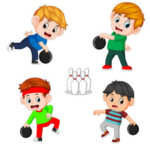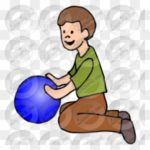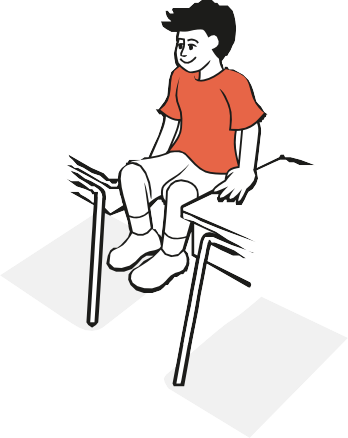
by Santosh | Jun 12, 2020 | Fitness Activity
Movement skills/concepts
Swinging on equipment, body and space awareness.
Set-up
Bars, ropes, playground/gymnasium equipment, desks, safety mats.
Children in small groups at each piece of equipment, with safety mats under the equipment.
Activity
Can you …?
- swing between two desks – on forearms first, then on hands, varying body shape (e.g. from tuck to long body)

- do a long swing from a horizontal bar, keeping the bars at chest height (it is better to bend your knees than to take chances) then swing to land and stand still
- do a long swing from one or two ropes
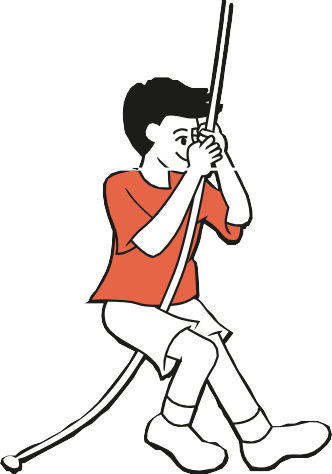
- run and swing to land as if you are swinging across an obstacle or to reach a set boundary (e.g. the other side of a river)
Can you see …?
- landings on toe–ball–heel and with bent knees
- soft surfaces below equipment
- sufficient strength to take the body weight
- spotting where needed
- constant hand grasp in all inverted positions – no sign of letting go or regrasping while inverted
You could ask …
Which pieces of equipment did you enjoy swinging on the most? What are safe ways of swinging?
Which types of swinging will you use when you are playing in the playground?
COOL DOWN/ CLOSURE
Review Skill/Activity, stretching, and questions.

by Santosh | Jun 12, 2020 | Fitness Activity
Movement skills/concepts
Rolling forwards, space awareness and body control.
Set-up
Beat board, mats, crash pads, high box, a slope.
Activity
Start the progressions for rolling forwards on a slope and then move to a level surface on the ground.
Tip over: Begin in a low squat position with your hands on the mat and your knees between your arms. Lean forward, tuck your chin to your chest and look back under your legs. Raise your hips until you tip over, bending your arms, and roll onto your back to a sitting position.
Try this again from a straddle stand and from a stand with two feet together.
Forward roll: Begin in a crouch position, with head up. Place your hands on the mat slightly forwards of your feet, with your fingers pointing forwards. Push your toes, raise your hips and tuck your chin to your chest to round your back. Land on the tops of your shoulders and push with your hands as you roll forwards to a crouch position.
Can you see …?
- slow, controlled movement
- chin to chest
- a natural arm bend
- back of head and shoulders contacting with the mat
You could ask …
What do you have to do with your body to tip yourself forwards? How do you roll forwards safely?
Variations
Roll on different surfaces: Try a forward roll on a crash pad or a box top, or on a line.
Create a forwards roll sequence: Forwards roll from a squat position, then forwards roll to straddle, forwards roll to stand? Include other rolls in the sequence as well, (e.g. backwards, egg roll, log roll).
COOL DOWN/ CLOSURE
Review Skill/Activity, stretching, and questions.
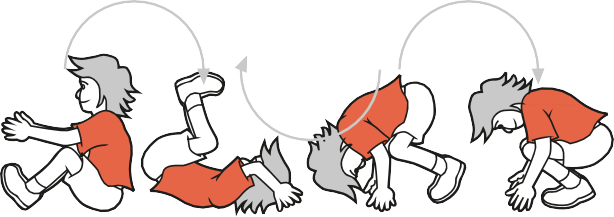
by Santosh | Jun 11, 2020 | Fitness Activity
Movement skills/concepts
Rolling backwards, body and space awareness.
Set-up
Mats, slope, crash pads.
Activity 1: Rolling backwards over the shoulder
- Sit on a level mat with your knees bent. Raise your arms, with the palms of your hands up and your fingers pointing backwards over your shoulders. Hold this position, then rock back to balance on your shoulders, putting your hands on the floor to support yourself. Hold for 4
- Backward shoulder roll down a slope. Sitting on top of a slope, roll backwards with your knees bent and one arm out to the side. Rock backwards to bring one leg over your head between the side arm and head. Land on your knee and bring the other leg to
- Now try 2 from a squat position, bringing both legs to the side of one ear and arms straight along
- Repeat 2 and 3 on a ground-level mat. Practise rolling to one side, then to the
Activity 2: Rolling backwards
Try these on the slope first and then on a level mat.
- Start from the sitting position, pointing your hands back behind your shoulders with palms up. Tuck your chin to your chest. Push off with your toes, keep your body tucked and your back round, roll onto your back and push off hands to land on knees, then take a squat
- Repeat as above but start from a squat and progress to a straddle, then go to a standing position, finishing in the same way as you
Can you see …?
- slow, controlled action
- chin to chest
- tucked body
- round back
- folding and unfolding action
- pushing arms straight
You could ask …
Why do we need to put our chin on our chest?
What shape do you make with your back? Why is this important?
Variations
Backward roll on equipment: Try rolling on a crash pad or a box top.
Make up a sequence: Include a balance, a jump and a roll in the sequence.
COOL DOWN/ CLOSURE
Review Skill/Activity, stretching, and questions.

by Santosh | Jun 11, 2020 | Fitness Activity
Movement skills/concepts
Rolling along a long axis, body control, space awareness and relationships (rolling with a partner).
Set-up
Mats. Children are spaced freely on a wooden floor or grass surface, sharing a mat with a partner.
Activity
Children do an individual log roll:
- lie on your back, stretched out, with your arms above your head and your hands clasped then, with a long, stiff body, roll from back to front to back
- do a log roll, one way and then the other
- do a log roll without letting your arms and legs touch the mat
Can you see …?
- maintaining a long body position
You could ask …
What do you need to do to keep you arms and legs off the ground when you are log rolling?
Variations
Log roll relay: In groups of 6, half are the rollers and the other half are the leapers. The two groups stand at opposite ends of a mat. On a signal, rollers (spaced apart) start log rolling down the mat. Leapers leap over the approaching rolling logs.
When rollers reach the end of the mat, the rollers become the leapers and the leapers become the rollers.
COOL DOWN/ CLOSURE
Review Skill/Activity, stretching, and questions.
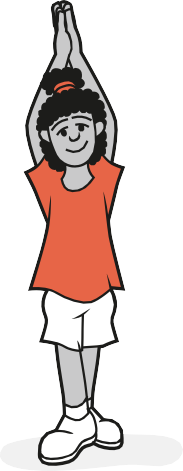
by Santosh | Jun 11, 2020 | Fitness Activity
Movement skills/concepts
Turning around a long axis, space awareness, body control, and time and energy.
Set-up
Music. Children are spread out in a general space, on a floor or hard surface that is easy to turn on.
Activity
On a signal, rotate or spin around:
- on your bottom (hands, no hands)
- on your stomach
- on your back
- tall like a flagpole
- like a screwdriver turning a screw
- like a washing machine
- like a revolving door
- to ‘tell the time’ (e.g. jump and turn to 3 o’clock)
Standing on two feet, jump with a straight body and make: a quarter (90 degrees) turn; a half (180 degrees) turn; a three-quarter (270 degrees) turn; and a full (360 degrees) turn.
Can you see …?
- change of focal point
- turning tall
- balance
- use of arms and legs to control turn
You could ask …
How does extending/moving your legs out affect your turn? What happens when you tuck/hold your body in close?
Variations
In–out game: One child is the leader making the calls. On a call of ‘Out’, children stand and turn with their hands out like a clothes line. On a call of ‘In’, they bring their hands in and spin like a ballet dancer. On a call of ‘In–out–in–out’, those who make a mistake move to the side of the area but continue the activity. The game continues until one child is left in the middle. Change leaders and repeat activity.
COOL DOWN/ CLOSURE
Review Skill/Activity, stretching, and questions.
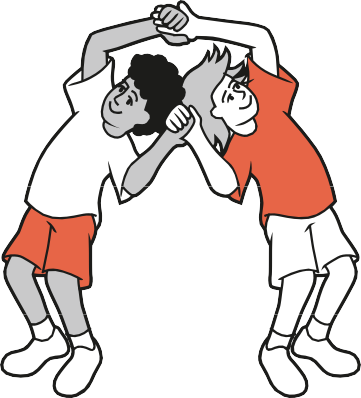
by Santosh | Jun 11, 2020 | Fitness Activity
Movement skills/concepts
Discovering swinging, space awareness and relationships (with others).
Set-up
Suitable music.
Children are spread out in a defined space in a grass or hard area.
Activity
Children discover swinging.
- Which parts of your body can you swing?
- Can you swing side to side, backwards and forwards, in circles and figures of 8?
- Who can swing high, medium and low?
- Can you swing fast, slow, increasing/decreasing in speed?
- Who can make different shapes or patterns with their swing?
- Show me an animal that
- Can you swing when kneeling, lying, sitting?
- Show me how you swing to
- Join one hand with a partner and see how many ways you can swing your joined
- How else can you swing in pairs? Try washing the
Can you see …?
- relaxed swinging
- rhythmical movements
You could ask …
Which way of swinging did you enjoy the most?
How many different ways did you swing your body parts?
Variations
Create a sequence: Make up a swinging sequence.
COOL DOWN/ CLOSURE
Review Skill/Activity, stretching, and questions.











